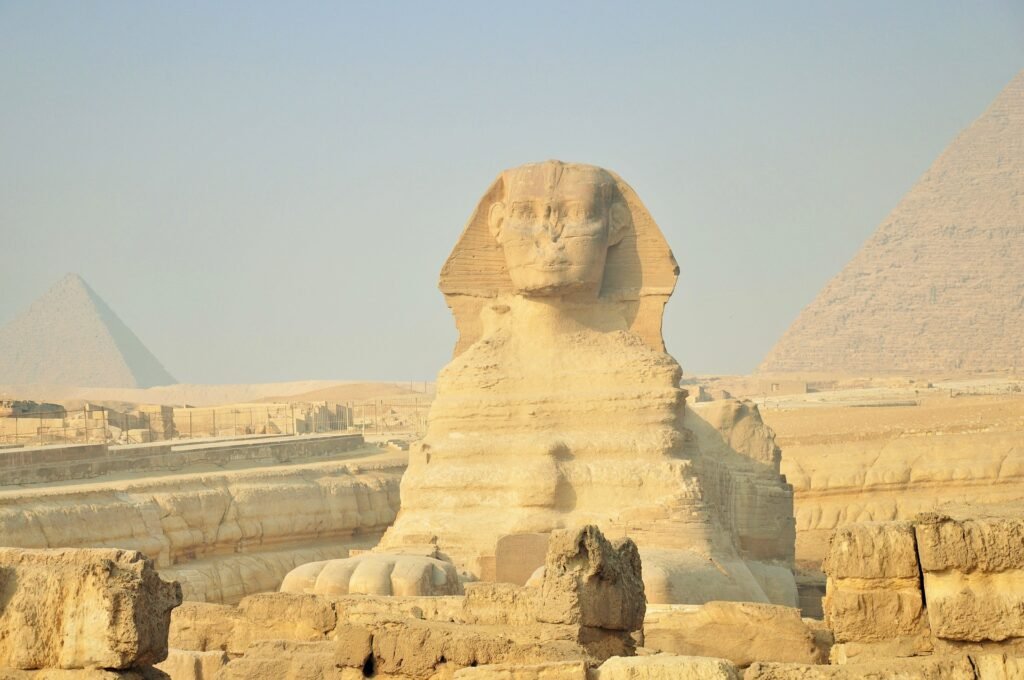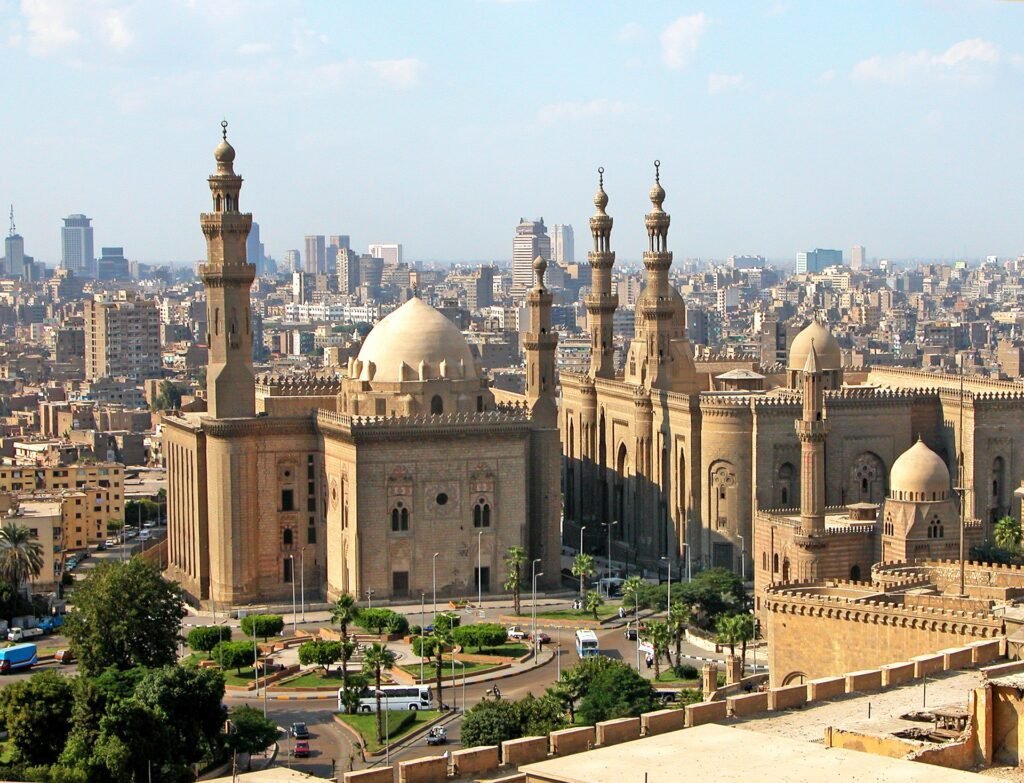Summing up this city in just a few worlds seems impossible – given its overwhelming size, abundance of diversity in all areas and inordinate frenzied energy. As the largest metropolis in the Arab world, the expansive space is a cohesive clutter of cultures, religions and historic monuments. Behind a spice-infused haze, a tangle of twisting lanes call for exploration, tucked away coffee shops promise respite and the banks of the Nile offer a moment of reflection on this truly unique destination.
Our Egypt tours to Cairo will show you not only the touristy temptations and the interesting places to visit but also the hidden secrets of a megacity that will continue to impress.
The Pyramids
Located on the outskirts of Cairo, these magnificent landmarks are three of many reasons why tourists flock to Egypt. Rest assured, that all who visit these towering man-made structures will not be disappointed. Constructed from massive giant stone blocks and encased in a layer of limestone, the pyramids are an incredible sight to behold. The biggest of the edifices, Khufu, towers over the Khafre and Menkaure pyramids. If marveling at these iconic ancient sites from below isn’t enough, you can even climb right down inside for a better look (a limited number of tickets are available for the Great Pyramid).
One of our local, enthusiastic Egyptologist guides will escort you around; provide you with detailed information and a varied array of historical facts.
For quick and easy access to these ancient sites, the chosen hotel for our Egypt tours is in close distance.
The Sphinx
Sitting proudly on the Giza Plateau, on the west bank of the Nile, the Sphinx is the oldest monumental sculpture in Egypt. This recognizable limestone statue is believed to have been built by the ancient Egyptians of the Old Kingdom. Modeled on a mythical creature with the body of a lion and the head of a human, the Sphinx’s face is thought to represent the Pharaoh Khafre.
On our Egypt tours to Cairo, we recommend making a booking to watch the spectacular sound and light show at the Giza Plateau. As night falls, the desert is illuminated with flashing lasers as a narrator tells the history of the ancient world.

Egyptian Museum
Another highlight on our Egypt tours is this haven of historical gems. Housing 120, 000 artifacts, this museum is the largest in the region. It was assembled in 1835 close to the Ezbekeyah Garden and later moved to the Cairo Citadel. The displays are spread over two main floors with the world’s greatest collection of Pharaonic antiquities.
Your expert guide will lead you through the exhibits, paying special attention to the intact tomb of Tutankhamen – an Egyptian pharaoh of the 18th dynasty. This king’s golden tomb was discovered in the Valley of the Kings, encircled by 5000 treasures. Outside of the museum lies a manicured garden serving as a memorial to the famous Egyptologists around the world.
Nile Cruise
What better way to start off your Egypt tour than with a cruise on the Nile? The world’s longest river runs north from the Equator to just north of Cairo upon which the city is set. Exchanging the chaotic roads for the calm waters allows you to see Cairo from a different perspective. Our tour recommends the optional dinner cruise – when the temperature is cooler and the buildings are illuminated on the side of the banks. You can feast on delicious local delicacies as the city lights up.
If you would rather watch the sound and light show at the Giza Plateau that evening, many of our Egypt tours include a Nile cruise at a later part of the trip. You will even get the chance to sleep on the deck of the felucca sailboat under the stars (mattresses, blankets and mosquito nets are provided).
To find out more information about this excursion on our tour, check out this this blog post.
Cairo Citadel
As you arrive in Cairo and are transferred to your hotel, the day is yours to relax or you can choose to take an optional tour. This city tour is led by your guide and will visit the Saladin Citadel of Cairo. This Islamic fortification is perched on Mokattam hill, close to the centre of Cairo and highly visible on Cairo’s eastern skyline.
Boasting an impressive vista of the city below, this citadel contains a gathering of museums, mosques and palaces. Fixed on a limestone spur, the citadel created by Saladin in 1176 functioned as a fortification against the crusaders and was home to Egyptian rulers for 700 years. UNESCO declared this monument to historical warfare a World Heritage Site in 1976.
Bab al-Futuh Gateway
As the Egypt tour makes its way further into the city, your guide will point out the Bab al-Futuh Gate. This elevated entrance also known as the Gate of Conquest is one of three remaining gates in the walls of the Old City. The arch of the gateway is adorned with patterns and motifs and the building features two towers.
The gate was constructed in 1087 by Commander Vizier Badr al-Jamali of the Fatimid Caliphate. It was created to mark the northern boundary of the old Fatimid City and in ancient times, pilgrims would return through the gate each year. As you pass the gate, you will be met by a collection of twisting backstreets, each dedicated to spices, pottery, fabric, jewelry and metalwork.

Khan el-Khalili
Those looking to pick up souvenirs from their trip will find plenty of enticing trinkets at this souk in the historic centre of Islamic Cairo. This bustling bazaar is one of Cairo’s major tourist attractions and our Egypt tour will give you ample time to indulge in some retail therapy. This market place rests on the burial site of the Fatimid Caliphs and is now occupied by Egyptian merchants, traditional workshops, restaurants, food vendors and coffee shops.
After browsing the multitude of colourful stalls, the tour will stop off at a coffee shop for a much-needed break, a cup of Arabic coffee and to try a shisha pipe. As night falls, the tour might even enjoy an early dinner – and tuck into Egypt’s unofficial national dish – Kushari. This hearty and spicy meal of mixed rice, tomato sauce, onions, cumin and chickpeas was originally made in the 19th century.
Mohamed Ali Mosque
This mosque, rising from the summit of the citadel was the largest to be built in the first half of the 19th century. It’s hard to miss this prominent shrine with its striking twin turrets and elaborate profile. Commissioned by Muhammad Ali Pasha between 1830 and 1848, this Ottoman mosque was erected in memory of his oldest son.
Given the vast use of stone on the exterior walls and internal surfaces, the mosque is also referred to as the ‘Alabaster Mosque’. It is important to realize that the mosque of Mohamed Ali is not designed in a similar fashion to that of other structures in Cairo and strongly differs from other houses of worships. This is partly the reason that our Egypt tour will make sure you get a close up view of the most prominent Islamic monument in Cairo – one that is even considered to be a symbol of the city.

Coptic Cairo
The Egypt tour will also explore Coptic Cairo – a section of Old Cairo, featuring Coptic churches, the Babylon Fortress, the Coptic Museum and religious monuments. In Christian tradition it is believed that the Holy Family frequented the area before the Islamic era and Coptic Cairo was a refuge for Christianity in Egypt.
You will feel easily enchanted by the surrounding charming, historic buildings with some dating back to the 6th century BC. Your guide will point out sights of interest and intrigue like the Mosque of Amr Ibn El-Aas – one of the oldest most important Islamic monuments in Egypt and the Ben Ezra Synagogue – where baby Moses was believed to have been found. Before the tour leaves, you can light a candle at the Hanging Church, a sanctuary of spiritual significance and one of the oldest constructions in Coptic Cairo.
Wikalat al Ghuri – Al Guri Sufi Show
On the final night of many of our Egypt tours, you will get the chance to watch a traditional Al Guri Sufi show – a flamboyant display of music, colour, dervish inspired dance and percussion. Occurring twice a week, this festive demonstration is held at the Wikalat al Ghuri – a 16th century marketplace, positioned opposite the mosque and mausoleum of the same name. This beautiful space created around a central courtyard features a domed roof, detailed arches and exquisite Islamic architecture. It is one of the best-preserved examples of this type of building in Cairo and a magical spot to conclude your special holiday in Egypt.







